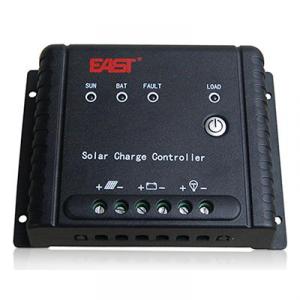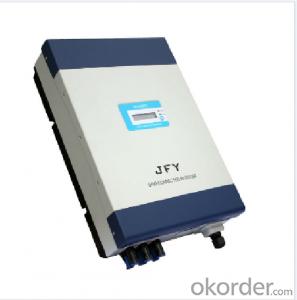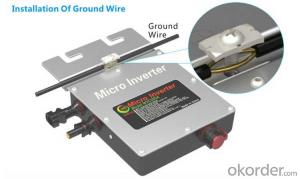2KVA/3KVA Inverter MPPT solar charge controller
- Loading Port:
- Shekou
- Payment Terms:
- TT OR LC
- Min Order Qty:
- 100 pc
- Supply Capability:
- 30000 pc/month
OKorder Service Pledge
OKorder Financial Service
You Might Also Like
Main Features
Pure sine wave inverter
Built-in MPPT solar charge controller
Selectable input voltage range for home appliances and personal computers
Selectable charging current based on applications
Configurable AC/Solar input priority via LCD setting
Compatible to mains voltage or generator power
Auto restart while AC is recovering
Overload and short circuit protection
Smart battery charger design for optimized battery performance
Cold start function
Rated Power 2000VA/1600W 2000VA/1600W 3000VA/2400W 3000VA/2400W
INPUT
Voltage 120 VAC or 230 VAC
Selectable Voltage Range 95-140 VAC or 170-280 VAC (For Personal Computers)
65-140 VAC or 90-280 VAC (For Home Appliances)
Frequency Range 50 Hz/60 Hz (Auto sensing)
OUTPUT
AC Voltage Regulation (Batt. Mode) 110/120 VAC ± 5% (User selectable) or 230VAC ± 5%
Surge Power 4000VA 6000VA
Efficiency (Peak) 90% - 93%
Transfer Time 10 ms (For Personal Computers)
20 ms (For Home Appliances)
Waveform Pure sine wave
BATTERY & AC CHARGER
Battery Voltage 24 VDC 48 VDC 24 VDC 48 VDC
Floating Charge Voltage 27 VDC 54 VDC 27 VDC 54 VDC
Overcharge Protection 31 VDC 62 VDC 31 VDC 62 VDC
Maximum Charge Current 20 A or 20 A / 30 A* 10 A or 10 A / 15 A* 20 A or 20 A / 30 A* 10 A or 10 A / 15 A*
SOLAR CHARGER
Maximum PV Array Power 1500 W 3000 W 1500 W 3000 W
MPPT Range @ Operating Voltage 30~ 115 VDC or 60 ~ 115 VDC 60 ~ 115 VDC 30~ 115 VDC or 60 ~ 115 VDC 60 ~ 115 VDC
Maximum PV Array Open Circuit
Voltage 145 VDC
Maximum Charging Current 60A
Maximum Efficiency 98%
Standby Power Consumption 2 W
PHYSICAL
Dimension, D x W x H (mm) 140 x 295 x 479
Net Weight (kgs) 11.5
OPERATING ENVIRONMENT
Humidity 5% to 95% Relative Humidity(Non-condensing)
Operating Temperature 0°C - 55°C
Storage Temperature -15°C - 60°C
- Q:Can a solar inverter be used with solar-powered electric vehicle charging stations?
- Yes, a solar inverter can be used with solar-powered electric vehicle charging stations. A solar inverter is necessary to convert the DC (direct current) power generated by solar panels into AC (alternating current) power that can be used by electric vehicle charging stations. This allows the solar power to be fed into the charging station and used to charge electric vehicles.
- Q:How does a solar inverter handle voltage drop in long cable runs?
- A solar inverter compensates for voltage drop in long cable runs by boosting the voltage to ensure efficient power transmission.
- Q:How does a solar inverter handle voltage drops in the electrical wiring?
- A solar inverter handles voltage drops in the electrical wiring by continuously monitoring the voltage levels and adjusting its output accordingly. It maintains a stable output voltage by boosting it when necessary to compensate for any drop in the wiring. This ensures that the solar power system operates efficiently and effectively, minimizing any potential power loss due to voltage drops.
- Q:Can a solar inverter be used in a commercial solar system?
- Yes, a solar inverter can be used in a commercial solar system. In fact, it is an essential component as it converts the direct current (DC) generated by the solar panels into alternating current (AC) that can be used to power commercial buildings and equipment. The solar inverter ensures efficient and reliable energy conversion, making it suitable for both residential and commercial solar installations.
- Q:How does a solar inverter handle grid frequency deviations?
- A solar inverter handles grid frequency deviations by continuously monitoring the frequency of the grid and adjusting its output accordingly. If the grid frequency deviates from the set nominal frequency, the inverter uses its internal control algorithm to regulate the power output from the solar panels to match the grid frequency. This ensures that the inverter stays synchronized with the grid and helps maintain stability in the overall power system.
- Q:Are there any safety concerns associated with solar inverters?
- Yes, there are some safety concerns associated with solar inverters. One of the primary concerns is the risk of electrical shocks or fires due to faulty installation or maintenance of the inverter. Additionally, some inverters may generate heat during operation, and if not properly ventilated, it can pose a fire hazard. It is crucial to follow proper installation guidelines, regularly maintain the inverter, and hire qualified professionals to minimize these safety risks.
- Q:Can a solar inverter work without sunlight?
- No, a solar inverter cannot work without sunlight as it relies on solar energy to convert the direct current (DC) produced by solar panels into alternating current (AC) for use in homes and businesses.
- Q:What is the typical lifespan of the capacitors in a solar inverter?
- The lifespan of capacitors in a solar inverter can differ based on various factors including component quality, operating conditions, and stress levels. On average, the expected lifespan is approximately 10 to 15 years. Capacitors serve a vital role in a solar inverter as they store and release electrical energy. They assist in voltage regulation, smoothing out power fluctuations, and providing stability to the electrical system. Several factors influence the lifespan of capacitors in a solar inverter. The quality of the capacitors themselves is a significant factor. Higher quality capacitors generally offer better performance and durability, resulting in a lengthier lifespan. Conversely, cheaper or lower-quality capacitors may deteriorate or fail more rapidly. Operating conditions also impact the lifespan of capacitors. Solar inverters are typically installed outdoors and are exposed to environmental factors such as temperature variations, moisture, and sunlight. Extreme temperatures, excessive humidity, or direct sunlight can accelerate capacitor deterioration and decrease their lifespan. Moreover, the stress placed on capacitors affects their lifespan. Voltage fluctuations, high-frequency switching, and overloading of the inverter can all contribute to this stress. Operating a solar inverter beyond its design limits or experiencing frequent power fluctuations can strain the capacitors, potentially resulting in premature failure. Regular maintenance and monitoring of the solar inverter are crucial for promptly identifying any potential capacitor issues. Some manufacturers may provide warranties or information on the expected lifespan of their capacitors, providing insight into their durability. In conclusion, the typical lifespan of capacitors in a solar inverter ranges from 10 to 15 years, but this can vary due to factors such as component quality, operating conditions, and stress levels. Regular maintenance and monitoring are essential for ensuring the capacitors' longevity and optimal performance within a solar inverter system.
- Q:How does a solar inverter handle voltage stability in the grid?
- A solar inverter manages voltage stability in the grid by regulating the voltage levels of the electricity generated from the solar panels. It ensures that the voltage produced by the solar panels matches the voltage required by the grid, thus maintaining a stable and consistent voltage throughout the system. Additionally, solar inverters may also have features like reactive power control and voltage regulation capabilities, which further contribute to maintaining voltage stability in the grid.
- Q:How does a solar inverter convert DC to AC?
- A solar inverter converts direct current (DC) electricity generated by solar panels into alternating current (AC) electricity that can be used to power appliances and feed into the electrical grid. It does this by using a complex electronic circuit that first converts the DC power into high-frequency AC power. This high-frequency AC power is then transformed into the desired voltage and frequency of standard AC power using pulse-width modulation techniques. The converted AC power can then be utilized for various household or commercial electrical needs.
1. Manufacturer Overview |
|
|---|---|
| Location | |
| Year Established | |
| Annual Output Value | |
| Main Markets | |
| Company Certifications | |
2. Manufacturer Certificates |
|
|---|---|
| a) Certification Name | |
| Range | |
| Reference | |
| Validity Period | |
3. Manufacturer Capability |
|
|---|---|
| a)Trade Capacity | |
| Nearest Port | |
| Export Percentage | |
| No.of Employees in Trade Department | |
| Language Spoken: | |
| b)Factory Information | |
| Factory Size: | |
| No. of Production Lines | |
| Contract Manufacturing | |
| Product Price Range | |
Send your message to us
2KVA/3KVA Inverter MPPT solar charge controller
- Loading Port:
- Shekou
- Payment Terms:
- TT OR LC
- Min Order Qty:
- 100 pc
- Supply Capability:
- 30000 pc/month
OKorder Service Pledge
OKorder Financial Service
Similar products
New products
Hot products
Hot Searches
Related keywords






























